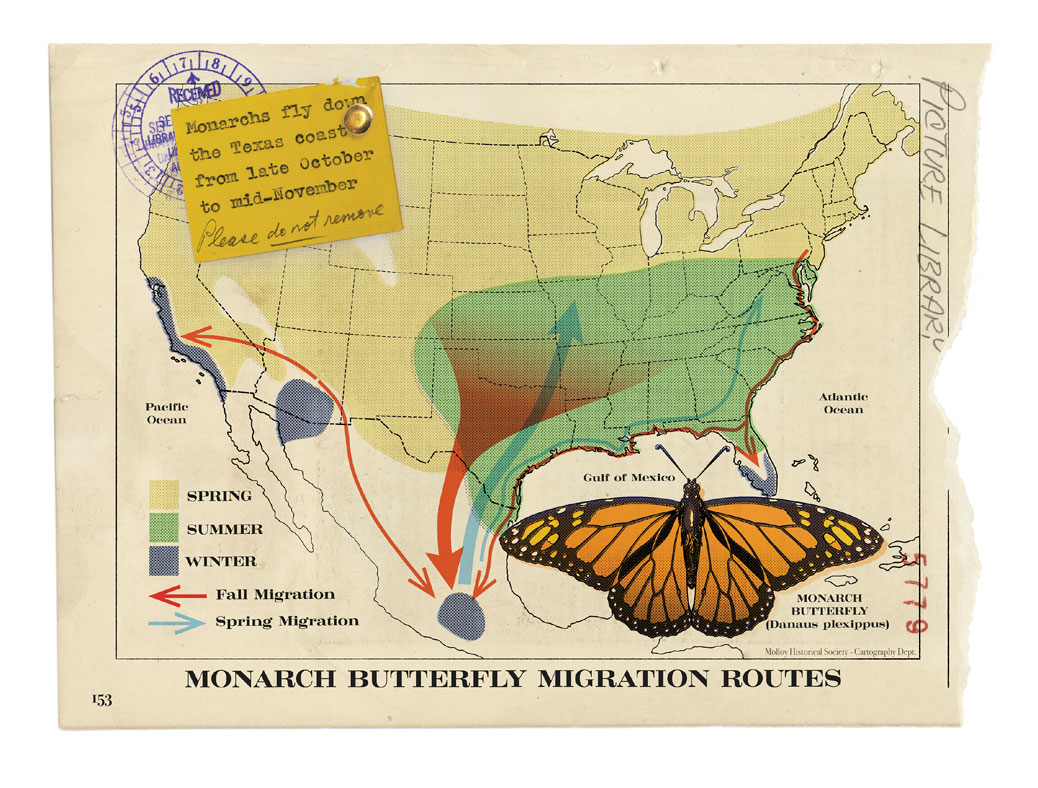
Early one morning on Trinity Bay, the autumn sky began to glisten. Myriad monarchs unfurled in clouds from the shoreline, fluttering overhead, some landing on our boat, on our fishing rods, and even on me and my husband. We watched, enchanted, as they danced ever-southward, propelled by a light north wind and their biological imperative.
Although monarchs heading south through Texas earlier in the fall primarily follow a migration route known as the central flyway, some of the most spectacular viewing arrives later, as the final wave of migrators flutters in more concentrated numbers along the coastal flyway. (The central flyway is more dispersed, stretching from Wichita Falls to Eagle Pass in a 300-mile swath.)
From about the third week of October through mid-November, these colorful creatures festoon our coastline. They feed on nectar-rich plants and roost in black-white-and-orange clumps numbering into the thousands—clinging to salt cedars and cattails along the coastal prairies, dunes, and beaches—only to sail aloft once the morning dew evaporates from their wings.
Known as the “super generation,” these butterflies are the fourth-or-fifth-generation descendants of monarchs that made the same southward journey the previous year. Unlike earlier generations that mated and laid eggs as they followed milkweed farther and farther north throughout the spring and summer—each cycle living for only about a month—the super generation suspends its ability to reproduce so all of its energy can fuel a 2,000-mile pilgrimage to wintering grounds in the oyamel firs of Mexico, where it hibernates in the very same forests as its great-great-grandparents. In the spring, this same super generation migrates northward to northern Mexico and the southern United States, where it reproduces and expires, beginning the cycle anew.
Sadly, many won’t make the journey: According to the U.S. Fish and Wildlife Service, monarch populations east of the Rocky Mountains have declined by roughly 80 percent over the past few decades due to factors including habitat loss and the widespread use of herbicides that eradicate milkweeds, the only plants on which monarchs lay eggs and their larvae feed. While milkweeds remain crucial to the species’ survival, the availability of nectar-producing plants in the fall determines whether the super generation can survive long enough to fly to its wintering grounds and return to lay eggs in the spring. “It’s a concern, and it has the public’s attention,” says Mike Quinn, an entomologist and director of Texas Monarch Watch.
To catch the coastal monarch wave, he says, timing is key. Quinn suggests tracking recent sightings via the Journey North website at maps.journeynorth.org or signing up for email notifications from Monarch Watch, a national organization. “The monarchs will cluster near the water’s edge and on points of land that jut southward,” he says. Coastal national wildlife refuges such as Anahuac, Aransas, Laguna Atascosa, and McFaddin, and coastal state parks such as Goose Island are good bets, as is the Lower Colorado River Authority’s Matagorda Bay Nature Park. Depending upon the weather and food availability, the monarchs may stay for several days or vanish that morning.
November in Texas brings sublime camping weather and bay fishing, so a hop down to the coast to send off the monarch (which is, after all, the official state insect) seems like hitting the trifecta. “It may not have the sheer numbers of the central flyway migration,” Quinn says. “Still, it can be spectacular.”








